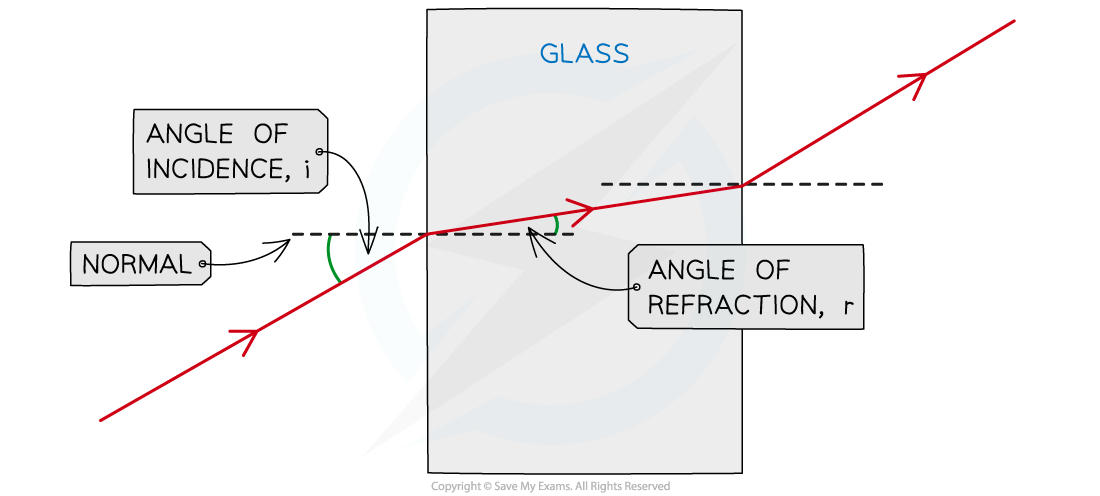Required Practical: Investigating Reflection & Refraction (AQA GCSE Physics): Revision Note
Exam code: 8463
Required Practical 9: Investigating Reflection & Refraction
Equipment List

Resolution of measuring equipment:
Protractor = 1°
Ruler = 1 mm
Experiment 1: Reflection of Light in a Mirror
Aims of the Experiment
To investigate specular reflection off a smooth surface
Variables
Independent variable = angle of incidence, i
Dependent variable = angle of reflection, r
Control variables:
Distance of ray box from mirror
Width of the light beam
Same frequency / wavelength of the light
Method

Apparatus to investigate reflection
Set up the apparatus as shown in the diagram
In the middle of the paper use a ruler to mark a straight line of about 10 cm long
Use a protractor to draw a 90° line that bisects (cuts in half) the 10 cm line
Place the mirror on the first line as shown in the diagram above
Switch on the ray box and aim a beam of light at the point where the two drawn lines cross at an angle
Use the pencil to mark two positions of the light beam:
A point just after leaving the ray box
The point on the reflected beam about 10 cm away from the mirror
Remove the ray box and mirror
Use a ruler to join the two marked positions to the point where the originally drawn lines crossed
Use the protractor to measure the two angles from the 90° line. The angle for the ray towards the mirror is the angle of incidence, and the other the angle of reflection
Repeat the experiment three times with the beam of light aimed at different angles
An example of the data collection table is shown below:

Analysis of Results
The law of reflection states:
i = r
Where:
i = angle of incidence in degrees (°)
r = angle of reflection in degrees (°)
If the experiment was carried out correctly, the angles should be the same, as shown below:

Law of reflection
Experiment 2: Refraction of Light By A Perspex Block
Aim of the Experiment
To investigate the refraction of light by a perspex block
Variables
Independent variable = angle of incidence, i
Dependent variable = angle of refraction , r
Control variables:
Use of the same perspex block
Width of the light beam
Same frequency / wavelength of the light
Method

Apparatus to investigate refraction
Place the glass block on a sheet of paper, and carefully draw around the block using a pencil
Switch on the ray box and direct a beam of light at the side face of the block
Mark on the paper:
A point on the ray close to the ray box
The point where the ray enters the block
The point where the ray exits the block
A point on the exit light ray which is a distance of about 5 cm away from the block
Draw a dashed line normal (at right angles) to the outline of the block where the points are
Remove the block and join the points marked with three straight lines
Replace the block within its outline and repeat the above process for a ray striking the block at a different angle
An example of the data collection table is shown below:

Analysis of Results
i and r are always measured from the normal
For light rays entering perspex block, the light ray refracts towards the central line:
i > r
For light rays exiting the perspex block, the light ray refracts away from the central line:
i < r
When the angle of incidence is 90° to the perspex block, the light ray does not refract, it passes straight through the block:
i = r
If the experiment was carried out correctly, the angles should follow the pattern, as shown below:

How to measure the angle of incidence and angle of refraction
Evaluating the Experiment
Systematic Errors:
An error could occur if the 90° lines are drawn incorrectly
Use a set square to draw perpendicular lines
If the mirror is distorted, this could affect the reflection angle, so make sure there are little to no blemishes on it
Random Errors:
The points for the incoming and reflected beam may be inaccurately marked
Use a sharpened pencil and mark in the middle of the beam
The protractor resolution may make it difficult to read the angles accurately
Use a protractor with a higher resolution
Safety Considerations
The ray box light could cause burns if touched
Run burns under cold running water for at least five minute
Looking directly into the light may damage the eyes
Avoid looking directly at the light
Stand behind the ray box during the experiment
Keep all liquids away from the electrical equipment and paper
Take care using the mirror
Damages on the mirror can affect the outcome of the reflection experiment

Unlock more, it's free!
Did this page help you?